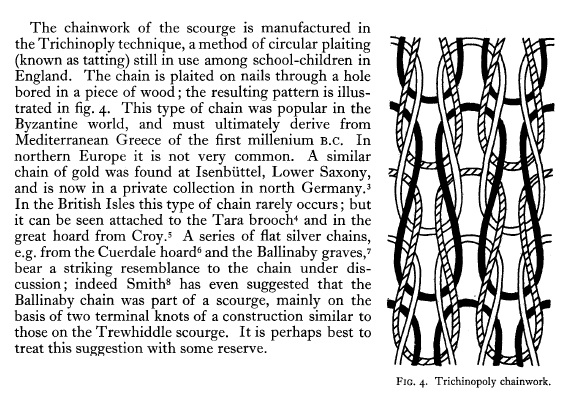So when I took that class at Gulf War, I was immediately excited when I saw the information that the teacher was presenting. Sad to say I actually remembered having run across it a couple of years earlier, while looking for something else. It was one of those things that I planned to “get back to”. I tried to explain to the teacher how important her information was and that she could use fiber terms to help her students to understand the structures that she was discussing. Her response – I don’t do fiber. OK. But a LOT of people do – more than the number of people who do metal. This is why I require my apprentices to have an open mind towards at least understanding the basic technology of crafts other than their own.
Back in 1774 a hoard was located in an old tin mine. Known as the Trewhiddle Hoard. It had some very unusual and unique metal items, including what is believed to be the oldest surviving Christian ceremonial scourge. The scourge was made of silver wire. The Reverand Philip Rashleigh managed to acquire most of the find and wrote a report on it in 1788, which was published in the Society of Antiquaries journal, Archaeologia, IX, 187. As was typical of many of the discoveries that occurred during this timeframe, a considerable portion of the original find has disappeared. Fortunately, the scourge has survived and is in the British Museum.
The original report by Rashleigh does not shed any light on the structure of the scourge, being a simple listing of the items that were found. The decision to call the technique Trichinopoly is lost somewhere in my archives. I thought that I had discovered the gentle’s name, but I can’t currently locate it. Supposedly the story was that being stationed at some point in Trichinopoly, India, a British Colonial Administrative District, the individual in question recognized the technique as something that he had seen in India, and gave the technique a name.
In 1961 D.M Wilson and C.E. Blunt published an article, again in Archaeologia (Jan 1961, Vol. 98) titled, The Trewhiddle Hoard. And they detailed the structure of the scourge wire.
 I have to admit, this brief excerpt makes my head hurt. Looking at the picture the structure of the scourge is obviously knit. The author’s description of the “circular plaiting” as tatting is incorrect. According to the Merriam-Webster’s Dictionary tatting is: a delicate handmade lace formed usually by looping and knotting with a single cotton thread and a small shuttle. My Mother used to make tatted doilies, I know what it looks like. Interestingly enough, their description of the spool knitting that the children were doing is correct at least as far as the structure of the “plaiting” is concerned. I decided to investigate the individual finds that are mentioned to try to determine if they were being consistent in the use of the word Trichinopoly, or not.
I have to admit, this brief excerpt makes my head hurt. Looking at the picture the structure of the scourge is obviously knit. The author’s description of the “circular plaiting” as tatting is incorrect. According to the Merriam-Webster’s Dictionary tatting is: a delicate handmade lace formed usually by looping and knotting with a single cotton thread and a small shuttle. My Mother used to make tatted doilies, I know what it looks like. Interestingly enough, their description of the spool knitting that the children were doing is correct at least as far as the structure of the “plaiting” is concerned. I decided to investigate the individual finds that are mentioned to try to determine if they were being consistent in the use of the word Trichinopoly, or not.
Next time: Consistent or Not, and Why is ANY of this Significant?
